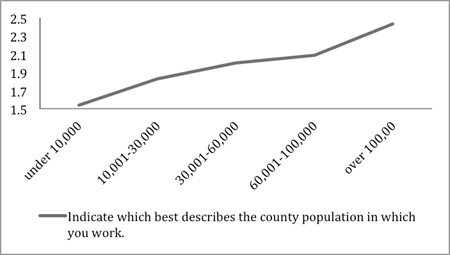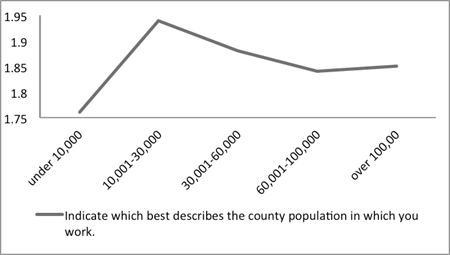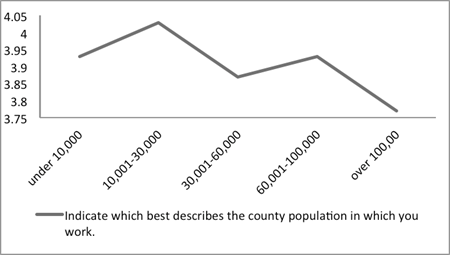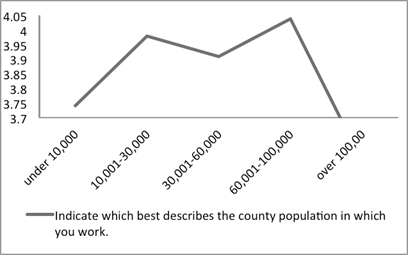 |
June 2015
|
June 2015 // Volume 53 // Number 3 // Research In Brief // v53-3rb2
Examining the Impact of Community Size on the Retention of County Extension Agents
Abstract
The study reported here examined job embeddedness, employee retention, and community size among Extension agents in a two-state study. Statistically significant differences in job embeddedness by community size were present. Analysis of the Variance (ANOVA) showed that five of six job embeddedness components were significantly different based on community size. Extension agents working in the most rural and most urban communities indicated the lowest levels of job embeddedness.
Introduction
Studies have shown that "86% of employers experience difficulty attracting new employees and 58% experience difficulty retaining their employees" (Ramlall, 2003, p. 63). There are two perspectives regarding this topic. Many have chosen to examine the reasons people leave; that is, the focus is on turnover. This is fundamentally an employer perspective.
An alternative point of view is to examine why people stay, that is, a focus on retention. This is mainly an employee perspective. Both are valuable and help answer important questions regarding job satisfaction, employee relations, and retention in the organization in general.
According to the United States Department of Agriculture, National Institute of Food and Agriculture (NIFA) (2010), approximately 8,000 Extension agents are employed in the U.S. Extension System. Although no national retention statistics for Extension are known, the fiscal benefits of increasing retention are substantial. For instance, a one-percentage-point increase in the overall retention rate of Extension agents nationwide could reduce organizational expenses by $6.4 million dollars annually (Kutilek, 2000; Young, Stone, Aliaga, & Shuck, 2013).
Although Extension-based retention studies examining community size are unavailable, there have been studies on the retention of medical professionals in rural and urban communities. Limited studies have been conducted in the medical field that found that community factors did not significantly impact retention (of nurses) in rural areas, nor was there a significant difference in retention between physicians living in rural and urban communities (Betkus & MacLeod, 2004; Horner, Samas, & Ricketts, 1993). However, Pathman, Williams, and Conrad (2008) found that physicians' retention was independently associated with their satisfaction in established relationships, clinical autonomy, and life in small communities. These studies do not directly relate to the role of Extension agent, but they have some relevance. The lack of research into any relationships between Extension agent retention and community size represents an important gap in knowledge that requires further examination. Table 1 shows a description of the study respondents by state.
Purpose
The study reported here investigated whether community populations impact retention among county Extension agents and to explore if any statistically significant differences exist between the mean responses of agents based on community population; Analysis of Variance (ANOVA) tests were employed. Findings indicated statistically significant differences in components of job embeddedness (Table 1).
| State A (%) | State A (n) | State B (%) | State B (n) | Total (%) | Total (n) | |
| Gender | ||||||
| Male | 36.4 | 84 | 39.2 | 157 | 38.2 | 241 |
| Female | 63.6 | 147 | 60.8 | 243 | 61.8 | 390 |
| Education | ||||||
| Bachelor's | 62.8 | 145 | 37.0 | 148 | 46.4 | 293 |
| Master's | 36.8 | 85 | 62.2 | 249 | 52.9 | 334 |
| Ph.D. | < 0.1 | < 0.1 | 1 | < 0.1 | 4 | |
| Race | ||||||
| Asian | < 0.1 | 2 | < 0.1 | 2 | ||
| Black | < 0.1 | 4.2 | 17 | 3.1 | 19 | |
| Hispanic | < 0.1 | < 0.1 | 1 | < 0.1 | 2 | |
| White | 98.7 | 228 | 95.0 | 380 | 96.3 | 608 |
| Average age (years) | 44.9 | 43.0 | 43.9 | |||
| Community Size | ||||||
| under 10,000 | 38.2 | 54 | 18.2 | 57 | 24.4 | 111 |
| 10,001-30,000 | 21.9 | 31 | 42.5 | 133 | 36.1 | 164 |
| 30,001-60,000 | 13.4 | 19 | 19.5 | 61 | 18.0 | 80 |
| 60,001-100,000 | 7.0 | 10 | 8.6 | 27 | 8.1 | 37 |
| over 100,000 | 19.1 | 27 | 11.1 | 35 | 13.4 | 62 |
| State A, N = 231; State B, N = 400 | ||||||
Comparisons of respondents with current demographic data provided by the two participating institutions showed no significant differences in gender, education level, and age. Respondents did differ in terms of race, but further analysis indicated no statistically significance differences.
Significance of Job Embeddedness
The exact costs related to employee turnover are unclear, but can be significant. Kutilek (2000) estimated the costs at $80,000 per employee, while Friedman, Galinsky, and Plowden (1992) estimated the costs at 150% of position salary. The implication is that as retention rates decrease, the associated costs negatively affect an organization's bottom line.
"Job embeddedness" refers to a relatively new construct that examines an individual's (a) links to other people, teams, and groups; (b) perceptions of their fit with the job, organization, and community; and (c) beliefs about what they would have to sacrifice if they left their jobs (Mitchell, Holtom, Lee, Sablynski, & Erez, 2001).
"Links" are defined as connections between people and institutions. Highly embedded individuals have many links to the workplace, community, or both. Examples of links include age, marital status, number of children and their ages, years of service, hobbies, church-related activities, and membership in community organizations.
"Fit" can be seen as perceived comfort with an organization and community. The closer that one's personal views, values, and goals align with the organizational culture of the employer, the better the fit and the "higher the likelihood that an employee will feel professionally and personally tied to the organization" (Mitchell et al., 2001, p. 9). Examples of community fit could include weather preferences, access to outdoor activities, entertainment, and political and religious climates.
The final component of the job-embeddedness construct is "sacrifice." In the study, sacrifice refers to the material and psychological benefits that could be lost if an employee leaves the organization. These sacrifices might include the corner office, health and retirement benefits, sports tickets, length of time in residence, distance to work location, safety, and leadership in the community.
The significant and unique aspect of job embeddedness is its ability to gauge the impact of community factors on an employee's decision to leave or remain in the current work situation (Young, 2013).
Methods
This article provides information on an exploratory study of county Extension agents in two states used to investigate mean differences based upon five different community populations: Under 10,000; 10,001 – 30,000; 30.001-60,000; 60,001- 100,000; over 100,000.
While the original instrument used in the study was composed of six different scales relating to the study's research questions, this article focuses on job embeddedness and demographic background data.
The study used a census survey of Extension agents within two states. One in the Southeastern U.S., the other in the Midwest. Census was used as the sampling approach because it allows for all elements of a population to be studied and can be useful in discovering the desired descriptive characteristics of a population (Johnson & Christensen, 2010).
Dillman, Smyth, and Christian's (2009) four-stage method and interval-scheduling framework was used in preparation to maximize response rates among potential participants. The process began with securing the consent of the respective state Extension Directors. Each Director sent messages to their Extension agents indicating their support for the study and the potential benefits it had for their organizations (Dillman et al., 2009). The data collection process began the following week. The use of this type of online survey makes replication in additional states relatively simple.
During the months of October and November of 2011, an email message was sent to Extension agents outlining the voluntary nature of the study, its objectives, confidentiality, and a link to the questionnaire, which included the consent preamble. The first reminder message was sent 1 week later to those who had not yet responded. A second reminder message was sent 14 days later, and a final reminder message was sent 21 days after the initial message. All reminder messages contained a link to the questionnaire (Dillman et al., 2009)
Out of the 631 agents surveyed, 454 responded to the survey, representing a 71.95% response rate. The high response rate can be at least partially attributable to following Dillman' s (2009) proven survey techniques and the work of Miller and Smith (1983) in regard to comparing responders and nonresponders. Miller and Smith also recommended that respondents and nonrespondents should be compared on a comprehensive set of socio-demographic-background characteristics. If there are no statistically significant differences, the results can be generalizable to the total population. Research has shown that late respondents tend to be similar to nonrespondents (Miller & Smith, 1983). In the study, nonresponse tests were between (a) population verses respondents, and (b) respondents verses nonrespondents. The chi-square test (also called Pearson's chi-square test) was used to examine whether statistical differences between the groups existed. Comparisons of respondents and nonrespondents showed no differences in gender, education level, and age. Respondents did differ from nonrespondents in terms of race, but further analysis with an Eta squared test indicated no practical significance.
In conclusion, study respondents appeared to be reasonably similar to both the total population and to nonrespondents.
Analysis
A review of the ANOVA statistic was conducted. Tukey's post hoc test was used to compare the mean among community sizes for significance. Results showed statistically significant differences do exist between the job embeddedness means. This is summarized in Table 2.
| N | Total mean (SD) | F (sig.) | |
| Total Job Embeddedness | 454 | 3.21 (.41) | 3.86* (.004) |
| Significance at .05 alpha level (2-tailed). | |||
A deeper examination of the specific components of job embeddedness, (e.g., links, fit, and sacrifice) on both organization and community perspectives give additional insight as to where the differences by community size originate. Table 3 below shows statistically significant differences in five of six job embeddedness components.
| N | M | F | P | |
| Links Organization | 454 | 1.89 | 17.51 | .00* |
| Links Community | 454 | 1.87 | 2.58 | .04* |
| Fit Organization | 454 | 3.93 | 2.38 | .05* |
| Fit Community | 454 | 3.89 | 2.42 | .05* |
| Sacrifice Organization | 454 | 3.65 | 2.22 | .06 |
| Sacrifice Community | 454 | 3.89 | 2.43 | .05* |
| Significance at p< .05 level. | ||||
Tukey's post hoc test was used to identify differences in job embeddedness (links, fit, sacrifice) and community size. Statically significant differences in organizational links were observed between all community sizes (Figure 1). Significant differences in community links were only observed between community sizes of under 10,000 and 10,001-30,000 (Figure 2).
Figure 1.
Mean Values Organization Links by Community Size
Figure 2.
Mean Values Community Links by Community Size
As noted previously, links are defined as connections among people, institutions and communities. The more links that an individual develops the more likely they are to remain with the organization. In the limited study reported here, those working in communities under 10,000 indicated significantly fewer linkages within their organization (Extension) and their community than those in other community sizes.
Differences in organizational fit were only observed between community sizes of 10,001 – 30,000 and over 100,000. Community fit differences were only observed between community sizes of under 10,000 and 10,001-30,000 (Figures 3 and 4).
Figure 3.
Mean Values Organization Fit by Community Size
Figure 4.
Mean Values Community Fit by Community Size

Fit is defined as perceived comfort with an organization and community. According to Job Embeddedness Theory, the closer that one's personal views, values, and goals are to the organizational culture of the employer, the better the fit and the "higher the likelihood that an employee will feel professionally and personally tied to the organization" (Mitchell et al., 2001, p. 9).
In the study reported here we can see that those in the most urban communities indicated the lowest levels of organizational fit (comfort) and that those in the most rural communities indicated the lowest levels of community fit (comfort) when compared to their colleagues.
The final component of the job embeddedness construct is sacrifice. Sacrifice refers to the material and psychological benefits that could be lost if an employee leaves the organization. No significant differences in organizational sacrifice were observed between community sizes (Figure 5). Significant differences were observed in community sacrifice between community sizes 10001-30000 and over 100000 (Figure 6).
Figure 5.
Mean Values Organizational Sacrifice by Community Size
Figure 6.
Mean Values Community Sacrifice by Community Size
The significant and unique aspect of job embeddedness is its ability to gauge the impact of community factors on an employee's decision to leave or remain in the current work situation. As indicated earlier, no previous studies were identified regarding the ability of job embeddedness and community size to impact the retention of Extension agents.
Discussion and Implications
An examination of the means of the individual states overall job-embeddedness scale and its individual factors (links, fit, and sacrifice), did show some statistically significant differences, which were paralleled by the retention rates for the two states involved. This appears to support the proposition that higher job embeddedness corresponds to higher retention rates, as supported by the work of other researchers (Mitchell, et al., 2001; Lee, Mitchell, Holtom, Sablynski, & Burton, 2004; Allen, 2006; Young et al., 2013).
Links
By examining the statistical significance of individual job embeddedness survey items, some general observations can be made about those working in both the smallest communities and the largest relative to an impact on retention. In regards to links, those working in the smallest communities (under 10,000) and those working in the largest communities (over 100,000) were least likely to have extended family living in the community.
Those working in the most rural counties had the shortest length of residence, lowest number of nearby friends, and lowest level of working spouses. They also indicated the fewest opportunities to connect organizationally and in the community than any other group.
Fit
The most rural and most urban respondents (respectively) were least likely to feel a part of their community in which they work. Rural respondents were most likely to be dissatisfied with the leisure activities offered in their communities and least likely to think of themselves as a good match for Extension.
Urban respondents (over 100,000) felt they had fewer commonalities, were least satisfied with co-worker relationships, and expressed the lowest enthusiasm regarding their professional group and development, whereas under 10,000 respondents had much higher levels of commonality and were most satisfied with co-worker relationships.
Urbanites and rural respondents, respectively, indicated the lowest levels of skill and talent use in their jobs. Urbanites did not feel they were a good fit with Extension values and goals.
Sacrifice
Similar to the previous domains of embeddedness, sacrifice is separated into two factors: sacrifice organization and sacrifice community. The most rural and most urban were least likely to value the benefits and/or perks associated with the job and were least likely to feel respected by the people they work with organizationally and in their communities.
Urbanites indicated the least enthusiasm for their promotional opportunities and would be least affected by leaving their organization or community. The most rural placed the least value on their health care and retirement benefits and indicated low confidence in their prospects for continued employment with Extension.
Conclusion
While the results of the study reported here cannot be generalized to other states because of the many unique and valuable differences that exist in Extension organizations, the findings provide evidence of a relationship among job embeddedness, community size, and retention indicators, thus demonstrating the predictive value of the job embeddedness construct.
The results of the study indicate potential retention issues for county Extension agents working in our most rural (under 10,000) and most urban (over 100,000) communities. An important point brought to light in the study was that in spite of a consistently high mean retention rate between the two states studied over the past 5 years (95.9%), the mean value of the variable job embeddedness (intent to stay) was moderate at best (3.25 on a 5-point Likert Type scale). It would seem that high organizational retention rates may be masking issues regarding Extension agents' intent to stay. It is possible that Extension agent retention will decrease if economic conditions improve and more job opportunities become available. These events and opportunities are described as shocks and are mediated by higher job embeddedness levels (Holtom, Mitchell, Lee, & Inderrieden, 2005). Mowbray (2001, p. 142) noted the need for Extension administration to address the following issues related to the retention of Extension agents:
- Explore ways to share or shift workloads (e.g., shared positions, flexible work time, compensatory time).
- Explore new and creative delivery methods to decrease the number of night and weekend activities.
- Starting salaries should be kept competitive with benchmark institutions and similar jobs.
- Administration should do a better job in providing recruits with realistic expectations.
- Administration should develop a formal exit interviewing process.
Additional effort should be made to address the sense of "disconnectedness" indicated by Extension agents working in our most rural communities. For many, this is their first job and first relocation, and despite close relationships with co-workers, these younger agents often feel disconnected from the communities they serve and undervalued by the Extension organization.
References
Allen, D. G. (2006). Do organization socialization tactics influence newcomer embeddedness and turnover? Journal of Management, 32, 237–256.
Allen, N. J., & Meyer, J. P. (1990). The measurement and antecedents of affective, continuance and normative commitment to the organization. Journal of Occupational Psychology, 63, 1-18.
Betkus, M. H., & MacLeod, M. L. P. (2004). Retaining public health nurse in rural British Columbia: the influence of job and community satisfaction. Canadian Journal of Public Health, 95, 54-58.
Dillman, D. A., Smyth, J. D., & Christian, L. M. (2009). Internet, mail and mixed-mode surveys. Hoboken, NJ: Wiley.
Friedman, D., Galinsky, E., & Plowden, V. (1992). Parental leave and productivity: Current research. New York: Families and Work Institute.
Holtom, B. C., Mitchell, T. R., Lee, T. W., & Inderrieden, E. J. (2005). Shocks as causes of turnover: What they are and how organizations can manage them. Human Resource Management, 44, 337–352.
Horner, R. D., Samsa, G. P., & Ricketss, T. C. (1993). Preliminary evidence on retention rates of primary care physicians in rural and urban areas. Medical Care, 31, 640-648.
Johnson, B., & Christensen, L. (2010). Educational research: Quantitative, qualitative, and mixed approaches. Thousand Oaks, California: Sage Publications.
Kutilek, L. M. (2000). Learning from those who leave. Journal of Extension [On-line], 38(1) Article 1COM1. Available at: http://www.joe.org/joe/2000june/iw2.php
Lee, T. W., Mitchell, T. R., Holtom, B. C., Sablynski, J. P., & Burton, J.P. (2004). The effects of job embeddedness on organizational citizenship, job performance, volitional absences, and voluntary turnover. Academy of Management Journal, 47, 711-722.
Lloyd, R. (2008). Discretionary effort and the performance domain. Unpublished thesis, Macquarie University, Sydney, Australia.
Luthans, F., Norman, S. M., Avolio, B. J. & Avey, J.B . (2008). The mediating role of psychological capital in the supportive organizational climate – employee performance relationship. Journal of Organizational Behavior, 29, 219-238.
Miller, L. E., & Smith, K. L. (1983). Handling nonresponse issues. Journal of Extension [On-line], 21, 45–50. Available at: http://www.joe.org/joe/1983september/83-5-a7.pdf
Mitchell, T. R., Holtom, B. C., Lee, T. W., Sablynski, C. J., & Erez, M. (2001). Why people stay: Using job embeddedness to predict voluntary turnover. The Academy of Management Journal, 44, 1102–1121.
Mowbray, J. (2001). Factors affecting turnover of county Extension agents in the University of Kentucky, Cooperative Extension Service (unpublished doctoral dissertation). University of Kentucky, Lexington, Kentucky.
Pathman, D. E., William, E. S., & Konrad, T. R. (2008). Rural physician satisfaction: Its sources and relationship to retention. The Journal of Rural Health, 12, 366-377.
Ramlall, S. (2003). Managing employee retention as a strategy for increasing organizational competitiveness. Applied H.R.M. Research, 8, 63–72.
Rich, B. L., Lepine, J .A., & Crawford, E. R. (2010). Job engagement: antecedents and effects on job performance. Academy of Management Journal, 53, 617-635.
U.S. Department of Agriculture, National Institute of Food and Agriculture, Extension. (2010) About us.
Young, J. A., Stone, J., Aliaga, O., & Shuck, B. (2013). Job embeddedness theory: Can it help explain employee retention among Extension agents? Journal of Extension [On-line], 51(4) Article 4FEA7, Available at: http://www.joe.org/joe/2013august/a7.php




